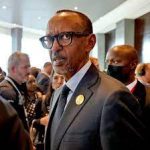While China and Russia Test Nukes, Biden Wants to Ban U.S. Testing

China is almost certainly detonating nuclear devices and definitely fast building its nuclear arsenal. War, likely to be fought with nuclear weapons, looks increasingly likely. To deter, the U.S. needs to go beyond subcritical testing and detonate a nuclear device. Pictured: An aerial view of the subsidence crater formed by the Huron King underground nuclear test in Nevada on June 24, 1980.
“Learning from Russia, China is likely developing Low Yield and Very Low Yield nuclear weapons…. to which the U.S. is not prepared to respond.” Richard Fisher of the International Assessment and Strategy Center, to Gatestone Institute, September 2023.
In short, China is almost certainly detonating nuclear devices and definitely fast building its nuclear arsenal. The Pentagon in a November 2022 report forecast that China would quadruple its warheads from about 400 then to 1,500 by 2035.
“For decades, they were quite comfortable with an arsenal of a few hundred nuclear weapons… to act as a deterrent. That expansion… they’re undertaking puts us into a new world that we’ve never lived in before, where you have… three great powers, essentially with large arsenals of nuclear weapons.” Secretary of the Air Force Frank Kendall, in testimony referring to China; stripes.com, March 28, 2023.
China is already thinking of first strikes with nukes. We do not have to speculate: Chinese officials… [have] threatened them.
China’s leader Xi Jinping may be preparing to make good on the threats. The simultaneous removal this summer of the top two officers of the Rocket Force, the branch of the Chinese military in charge of almost all of the country’s nuclear weapons, and 11 Rocket Force generals overall, suggest that Xi is installing officers who will obey commands to launch nukes.
Furthermore, across the other branches of the Chinese military, Xi is apparently removing officers opposed to war, including retired air force General Liu Yazhou, who is thought to have received a death sentence.
There are other interpretations for these moves, but all of them are ominous. War, likely to be fought with nuclear weapons, looks increasingly likely.
To deter, the U.S. needs to go beyond subcritical testing and detonate a nuclear device.
“We do not have the luxury of time as we have not modernized our nuclear forces for nearly four decades and our legacy systems are nearing the end of their already extended lives.” America needs to make sure that new systems work and old warheads still function. Peter Huessy, GeoStrategic Analysis, to Gatestone, September 2023.
America’s survival depends on its nuclear arsenal. As Huessy points out, disarmament advocates think the U.S. can deter adversaries and enemies with conventional forces only. That, he points out, ignores the reality of the battlefield: “Any use of nuclear weapons in a conflict would render the combat plans of our conventional combat commanders ineffective.”
Although the U.S. can learn much from computer simulations and other techniques, at some point the U.S. will have to detonate a nuclear device at least to validate three decades of assumptions.
The United States, therefore, must resume testing nuclear weapons now.
CNN on September 23 reported that, based on satellite imagery it had reviewed, China, Russia and the U.S. all are upgrading nuclear weapons testing facilities.
Although the news outlet states “there is no evidence to suggest that Russia, the U.S., or China is preparing for an imminent nuclear test,” it is clear that the world’s prohibition on nuclear testing cannot last long.
The United States should resume nuclear tests now.
An American test would not come out of the blue. “There are really a lot of hints that we’re seeing that suggest Russia, China, and the United States might resume nuclear testing,” Jeffrey Lewis of the James Martin Center for Nonproliferation Studies at the Middlebury Institute of International Studies told CNN.
A test of a nuclear device would lead, almost inevitably, to the end of what Daryl Kimball of the Arms Control Association has labeled “one of the most successful agreements in the long history of nuclear arms control and nonproliferation,” the Comprehensive Test-Ban Treaty of 1996. Kimball points out that 186 countries have signed the CTBT, as the pact is known, and made nuclear testing “taboo.”
America’s last test of a nuclear device occurred in 1992.
“As with other critical nuclear risk reduction, nonproliferation, and arms control agreements, the CTBT is under threat due to inattention, diplomatic sclerosis, and worsening relations between nuclear-armed adversaries,” writes Kimball this month in “Defending the De Facto Nuclear Test Ban.”
Kimball should also mention that the CTBT is ailing because belligerent regimes have ignored the agreement. The U.S. Defense Intelligence Agency and State Department have charged that Russia violated the U.S.’s “zero-yield standard” and suggested China also did not meet all its compliance obligations.
The State Department compliance report covering 2019, for instance, states that China’s “use of explosive containment chambers, extensive excavation activities at Lop Nur, and lack of transparency on its nuclear testing activities,” among other things, “raise concerns regarding its adherence to the ‘zero yield’ standard adhered to by the United States, the United Kingdom, and France in their respective nuclear weapons testing moratoria.”
The State Department notes that China had been “frequently blocking the flow of data” from monitoring stations to the Preparatory Commission for the Comprehensive Nuclear Test-Ban Treaty Organization.
“Learning from Russia, China is likely developing Low Yield and Very Low Yield nuclear weapons,” Richard Fisher of the International Assessment and Strategy Center told Gatestone. “The Chinese construction in Lop Nur would support the testing of such devices, to which the U.S. is not prepared to respond.”
In short, China is almost certainly detonating nuclear devices and definitely fast building its nuclear arsenal. The Pentagon in a November 2022 report, forecast that China would quadruple its warheads from about 400 then to 1,500 by 2035.
“For decades, they were quite comfortable with an arsenal of a few hundred nuclear weapons, which was fairly clearly a second-strike capability to act as a deterrent,” Secretary of the Air Force Frank Kendall stated in testimony in March, referring to China. “That expansion that they’re undertaking puts us into a new world that we’ve never lived in before, where you have three powers three great powers, essentially with large arsenals of nuclear weapons.”
China is already thinking of first strikes with nukes. We do not have to speculate: Chinese officials, both in and out of uniform, have throughout this century publicly threatened them. As Kendall testified, “I don’t think I’ve seen anything more disturbing in my career than the Chinese ongoing expansion of their nuclear force.”
China’s leader Xi Jinping may be preparing to make good on the threats. The simultaneous removal this summer of the top two officers of the Rocket Force, the branch of the Chinese military in charge of almost all of the country’s nuclear weapons, and 11 Rocket Force generals overall, suggest that Xi is installing officers who will obey commands to launch nukes.
Furthermore, across the other branches of the Chinese military, Xi is apparently removing officers opposed to war, including retired air force General Liu Yazhou, who is thought to have received a death sentence.
There are other interpretations for these moves, but all of them are ominous. War, likely to be fought with nuclear weapons, looks increasingly likely.
The U.S., China, and Russia have all conducted “subcritical” tests, which the CTBT does not prohibit because they do not create nuclear detonations.
The United States signed but has not ratified the CTBT, and President Joe Biden is committed to achieving Senate ratification. Fortunately, the Senate has so far refused to ratify it.
To deter, the U.S. needs to go beyond subcritical testing and detonate a nuclear device.
Why? For one thing, China and Russia have undoubtedly been detonating small nuclear devices.
As Peter Huessy of GeoStrategic Analysis told Gatestone, “We do not have the luxury of time as we have not modernized our nuclear forces for nearly four decades and our legacy systems are nearing the end of their already extended lives.” America needs to make sure that new systems work and old warheads still function.
America’s survival depends on its nuclear arsenal. As Huessy points out, disarmament advocates think the U.S. can deter adversaries and enemies with conventional forces only. That, he points out, ignores the reality of the battlefield: “Any use of nuclear weapons in a conflict would render the combat plans of our conventional combat commanders ineffective.”
The U.S. cannot allow its arsenal, as Huessy says, to “rust to obsolescence.” Although the U.S. can learn much from computer simulations and other techniques, at some point the U.S. will have to detonate a nuclear device at least to validate three decades of assumptions.
The United States, therefore, must resume testing nuclear weapons now.
egretnewseditor@gmail.com
























